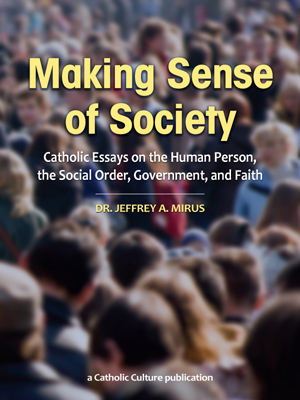Scorsese’s Silence is a contemplative masterpiece
By Thomas V. Mirus ( bio - articles - email ) | Jan 24, 2017 | In Reviews
Warning: this review contains spoilers. I also wish to note that this article grew out of conversations with two friends, to whom I owe many of the points made below.
Perhaps the most frequently noted characteristic of Silence—both book and film—is its ambiguity. Some revel in it, while others are deeply uncomfortable at best.
Most controversial is a scene in which the protagonist Rodrigues (Andrew Garfield), a young Portuguese Jesuit missionary to Japan, is told by his Japanese inquisitors to trample on a fumie, a bronze image of Christ, in order to save the lives of five Japanese Christians who are being tortured. These Japanese have already apostatized; their torment is solely for Fr. Rodrigues’s benefit. Almost out of his mind with horror and anguish, Rodrigues seems to hear the fumie-Christ speak to him, telling him: It’s all right, I understand, I came into the world to share your sufferings; go ahead and step. And so Rodrigues steps.
For all the critical focus on this scene, what is remarkable is how unambiguous the rest of Martin Scorsese’s film adaptation (which stays close to Shusaku Endo’s novel) actually is. Rodrigues’s apostasy is the climactic moment, close to the end of a film that is two hours and forty-one minutes long. For the previous two hours we have been treated to scenes of Christians bravely suffering and dying for their faith. Even an unbelieving audience member will likely have been brought to sympathize with their heroism by this point.
The inquisitors tempting Rodrigues to apostatize have been portrayed as alternately crafty and brutal, but always malicious. His former seminary teacher, an apostate who aids the inquisitors, is a pitiful mind-slave to the Japanese attempting to justify his own betrayal of the Church; Rodrigues himself sees this clearly and calls him a “disgrace.” After all this, whatever Rodrigues may think Jesus is saying to him and whatever pressure he is under, his apostasy feels to us like a failure.
Even taking the moment by itself, there are a few signs that the film takes a negative view of Rodrigues’s apostasy. But to me, a far more interesting question is, why does Rodrigues fail?
We are given warning signs throughout the film. One of Rodrigues’s interrogators, a Japanese interpreter (Tadanobu Asano, in one of the film’s best performances), even predicts it, remarking to the guards: “He’s an arrogant one. That means he will fall.” The same interpreter tells Rodrigues of an earlier padre in Japan, one Cabral, who held Japanese culture and customs in contempt, teaching Portuguese to the natives but never learning more than a few words of Japanese himself. Rodrigues protests, “I’m not like him.” This may be true in that Rodrigues shows no sign of a European superiority complex, but there is a similar spiritual dynamic in his attitude toward the simple faith of the Japanese Christians.
He is always teaching them, never learning. When the Christian peasants, long deprived of outward manifestations of faith, display intense devotion to the little religious objects he brings them, he worries that they place a higher importance on the symbols of faith than on faith itself. (In the book, Rodrigues is concerned that they are more devoted to Mary than to Jesus—a huge red flag that he is an intellectual elitist.)
When Kichijiro (Yosuke Kubozuka), who has apostatized and betrayed Rodrigues multiple times, returns once again begging to have his sins taken away, Rodrigues bursts out in disgust: “Do you even understand what absolution means?” Perhaps the pathetic Kichijiro, who resembles us in confessing and committing the same sin over and over, understands it better than Rodrigues. (I could write a separate article just about Kichijiro, a very important foil for Rodrigues, and perhaps I will at some point.)
When a fellow captive, soon to be martyred, says to him that in Paradise, there will be no more hunger, no more taxes, no more work, he affirms her words, repeating them back to her, but stiffly and almost with irony. He cannot comprehend why this group of Japanese Christians is calmer at the prospect of imminent death than he is, and rather than embracing the simplicity and earthiness of the woman’s thought he can only look down on it as the naïve, distorted faith of a peasant. He tells them he admires their courage, but all he can see is their suffering. He continually complains of the silence of God in the face of this suffering, but fails to recognize that God is speaking to him precisely through what he witnesses.
It is almost as though if their faith does not live up to his intellectual level, their martyrdom does not count. He would never consciously think such a thing, of course, but perhaps it is why he perversely holds himself to a higher standard, advising some of them to trample the fumie to save their lives while holding on to the hope of a glorious martyrdom for himself. In a disturbing voiceover line that is easy to miss, he reflects that Kichijiro, who alone of this group apostatizes, “succeeded” where his companions “failed.”
It is to his credit, at least, that when Rodrigues’s intellectualism is given full and coherent voice by his old teacher Ferreira (Liam Neeson), he sees it for what it is. Ferreira argues precisely that the martyrdom of the Japanese Christians has never been true Christian martyrdom because they do not understand God in the same way as European Christians. The Japanese, he insists, cannot imagine anything that transcends the human, and so Christianity in Japan is inevitably corrupted. Rodrigues rejects this line of thinking entirely, charging Ferreira with mere rationalization of his own apostasy.
I have argued that Silence is far from neutral when it comes to its protagonist’s apostasy. But why make use of ambiguity at all? Why not present things in a more straightforward or even moralistic manner? Certainly there is nothing wrong with this approach to storytelling, but a more straightforward or didactic approach would not serve this film well either in itself or in the effect it has on the audience. In hiding its hand and leaving much to subtext, the film forces the viewer to confront himself, to think more deeply, and even to engage in the Ignatian practice of discernment of spirits. As a friend of mine remarked, it functions like a parable; those who have eyes to see will see, those who bring in false preconceptions may interpret the movie in light of them if they wish, and some will simply be baffled.
Indeed, viewing the film is a contemplative experience, almost like going on retreat. In accordance with the title, Silence has no soundtrack to tell us when and what to feel; what we hear is what the characters hear, and Rodrigo Prieto’s beautiful cinematography (which has received the film’s sole Oscar nomination) and the outstanding performances of the American and Japanese cast draw us in. As in lectio divina (and recalling another great Catholic novel/film, Diary of a Country Priest), we are asked who we are in the story, and how we would respond in the same situation. Our prior assumptions about how we would respond are challenged, especially when we ask why the characters respond as they do—a question we would be less likely to ask at all if the film left us balanced and comfortable with easy answers.
What is most ambiguous about Silence is not so much the choice to apostatize but the state of Rodrigues’s mind and soul after his fall. Scorsese’s most notable departure from the novel is to end on a note of possible hope and redemption which Endo did not provide; it is not a guarantee, but then the human heart is a mystery.
All comments are moderated. To lighten our editing burden, only current donors are allowed to Sound Off. If you are a current donor, log in to see the comment form; otherwise please support our work, and Sound Off!








